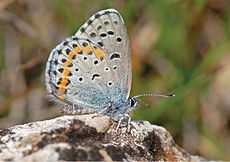Pseudophilotes bavius
| Pseudophilotes bavius | |
|---|---|
 | |
| Scientific classification | |
| Kingdom: | Animalia |
| Phylum: | Arthropoda |
| Class: | Insecta |
| Order: | Lepidoptera |
| Family: | Lycaenidae |
| Genus: | Pseudophilotes |
| Species: | P. bavius |
| Binomial name | |
| Pseudophilotes bavius (Eversmann, 1832) | |
| Synonyms | |
| |
The Bavius Blue (Pseudophilotes bavius) is a butterfly of the Lycaenidae family. It is found in Morocco, Algeria, Hungary, Greece, Asia Minor, southern Russia and northern Kazakhstan.[1] The species occurs in small isolated populations on flower-rich, dry grassland, on dry, stony slopes and on open patches in shrub and in vineyards on calcareous soil.
The wingspan is 24–30 mm. Adults are on wing from April to May and again from June to July in two generations per year. There is usually one prolonged generation a year with adults on wing from late April to mid July. In Peloponnesus, a partial second generation may occur.[2]
The larvae feed on Salvia species, including Salvia officinalis, Salvia nutans, Salvia verbenaca and Salvia verticillata. They feed mostly on the flowers, but sometimes also on the leaves. They are frequently found with ants. Hibernation takes place in the pupal stage.[3]
Subspecies
- Pseudophilotes bavius bavius (steppe of southern Russia, northern Kazakhstan)
- Pseudophilotes bavius casimiri Hemming, 1932 (Peloponnesus)
- Pseudophilotes bavius hungarica (Dioszeghy, 1913) (Transylvania)
- Pseudophilotes bavius fatma (Oberthür, 1890) (Morocco: Middle Atlas, Algeria: Aures Mountains)
- Pseudophilotes bavius egea (Herrich-Schäffer, [1852]) (Caucasus)
- Pseudophilotes bavius macedonicus Schultze, 1958 (Macedonia)
- Pseudophilotes bavius eitschbergeri (Koçak, 1975) (Turkey)
- Pseudophilotes bavius vanicola (Koçak, 1977) (Turkey)
References
- ↑ Pseudophilotes at funet
- ↑ treknature
- ↑ C. Van Swaay et al. (2012). "Dos and Don'ts for butterflies of the Habitats Directive of the European Union". Nature Conservation 1: 73. doi:10.3897/natureconservation.1.2786.